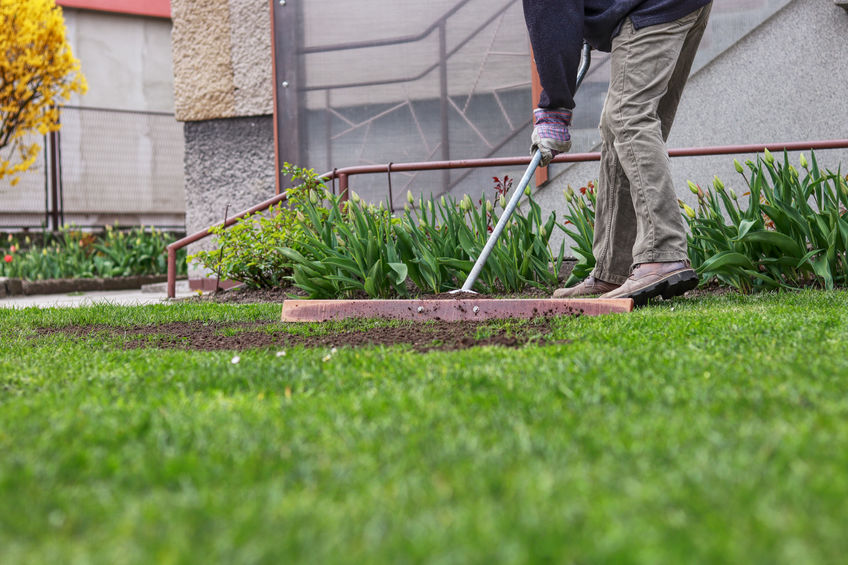A lumpy, uneven backyard can be an eyesore and difficult for homeowners to maintain. For this reason, many people turn to professional landscapers to fix irregularities and create a level yard.
For those with the time and desire to fix their own backyard, it may be possible depending on the extent of the problem. Below are some steps homeowners can take to achieve a more level yard.
Why a Level Yard is Important
One of the most obvious problems with an uneven backyard is that it presents a safety hazard. People walking through the yard can trip all too easily when the ground is not level. Safety is even more of a concern for homeowners with children who spend a lot of time playing outdoors.
Improving lawn health is another good reason to level an uneven backyard. The lawnmower won’t jump around due to uneven surfaces nor will the person mowing the lawn feel discomfort when pushing the mower over lumps and bumps.
When lawnmower tires pass over a sunken spot on the lawn, it can cause the blades to drop and cut the grass so low it may end up looking bald. Finally, leveled lawns drain water much more efficiently than unleveled lawns. Lawn disease is more likely when water doesn’t runoff as it should.

How Lawns Become Unleveled
Before tackling an unleveled yard, it’s important to understand how the problem developed in the first place. Underlying issues that the homeowner was not aware of are often to blame.
Here are some of the most common causes of a bumpy backyard:
- Irrigation pipes have eroded underground
- Improper draining of water
- Improperly installed sprinkler system
- Ground settling
- Lawn disease
- Insect and/or rodent infestation
- Buried debris
- Animals digging holes in the lawn
- Large ant mounds
Determining the root cause of the leveling problem is essential to prevent it from recurring after the homeowner invests time and money into leveling the lawn.
How to Proceed When Leveling a Backyard Alone
Leveling a backyard should take one person one or two full days as long as they’re in decent physical shape and have the proper equipment. Homeowners will need to purchase, borrow, or rent the following pieces of equipment to level their yard if they don’t own them already:
- Ball of string
- Brick layer’s level, carpenter’s level, line level, or string level
- Cart or wheelbarrow
- Compost
- Flathead shovel
- Four stakes
- Lawn roller
- Mulch or topsoil
- Mower
- Push broom
- Sand
- Tiller
Prep Work and Grading the Lawn
After ensuring that they have the right tools lined up, homeowners should do a visual scan of the yard to look for bumpy and lumpy areas. The problem may be in just one part of the lawn or cover the entire lawn. Taking this step helps homeowners avoid digging up parts of their yard unnecessarily.
Most backyards require grading before leveling. This process helps drain water away from the lawn and home before it can cause extensive damage to either one of them.
Grading a lawn involves sloping the yard away from the home’s foundation to allow excess water to drain rather than remain pooled and stagnant.
The homeowner is ready to start the leveling process after completing grading and a quick visual inspection. Following the visual inspection, walk around the yard and mark areas with bumps, lumps, or ridges to make them easy to find later.
De-Thatching and Leveling
Next, remove thatch build-up on the lawn. This may require renting a dethatching machine for larger yards or those with multiple uneven areas.

The next step involves applying a topsoil mix to smooth out the rough spots and reduce the size of the bumps with a shovel. Next, dig up divots deeper than three inches and any low areas of grass.
The homeowner should then place topsoil into the newly dug holes and replace the disrupted turf. If the soil doesn’t loosen easily, renting a tilling machine can help with that process.
Driving a stake into each of the four corners of the area needing leveling helps people avoid working on areas of the lawn that don’t require it. Tie strings to the stakes to create a rectangle or square and adjust the line level and string approximately every three to five feet to determine which areas to raise and which to lower.
The homeowner should then flatten the soil with the backside of a rake, water the newly leveled soil, and spread grass seed across it.
It’s Best to Leave Big Jobs to the Professionals
Grading and leveling a backyard is labor intensive and requires many pieces of large or expensive equipment to undertake. Additionally, you may end of with a large pile of excess dirt to haul away.
Therefore homeowners should consider hiring a professional like the pros at Have Dumptruck, Will Travel.

